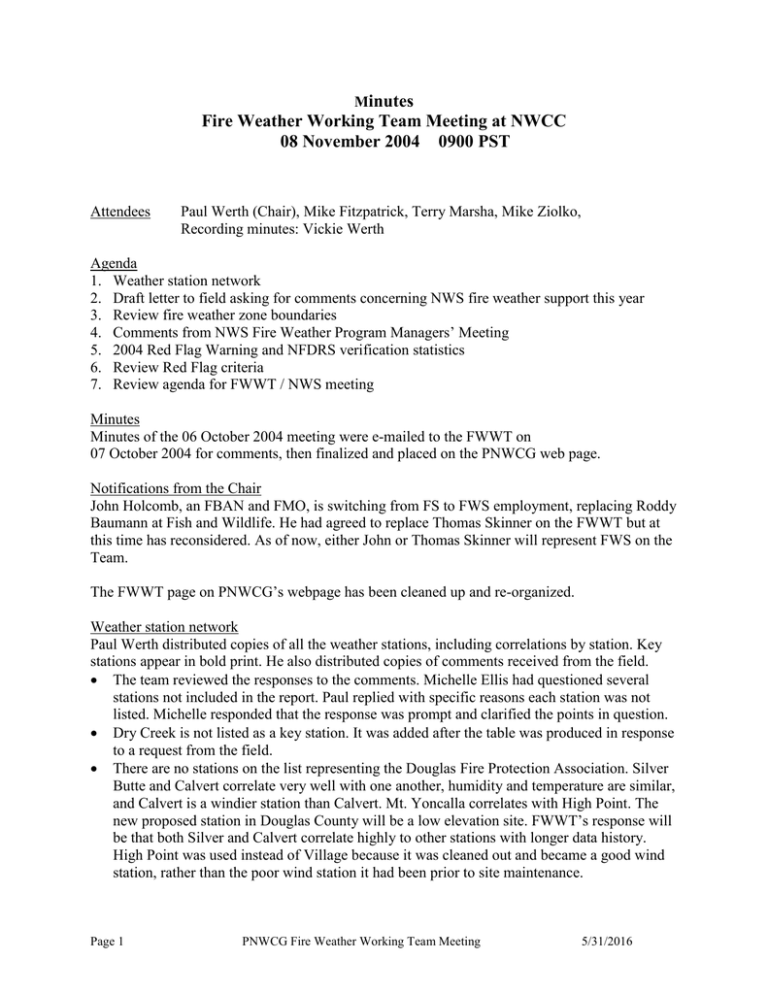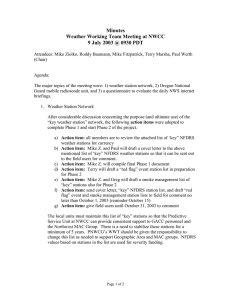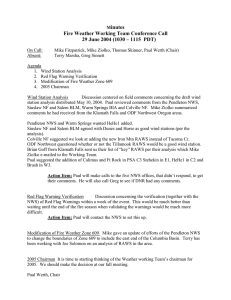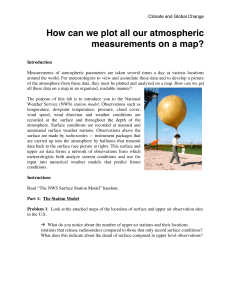inutes Fire Weather Working Team Meeting at NWCC
advertisement

Minutes Fire Weather Working Team Meeting at NWCC 08 November 2004 0900 PST Attendees Paul Werth (Chair), Mike Fitzpatrick, Terry Marsha, Mike Ziolko, Recording minutes: Vickie Werth Agenda 1. Weather station network 2. Draft letter to field asking for comments concerning NWS fire weather support this year 3. Review fire weather zone boundaries 4. Comments from NWS Fire Weather Program Managers’ Meeting 5. 2004 Red Flag Warning and NFDRS verification statistics 6. Review Red Flag criteria 7. Review agenda for FWWT / NWS meeting Minutes Minutes of the 06 October 2004 meeting were e-mailed to the FWWT on 07 October 2004 for comments, then finalized and placed on the PNWCG web page. Notifications from the Chair John Holcomb, an FBAN and FMO, is switching from FS to FWS employment, replacing Roddy Baumann at Fish and Wildlife. He had agreed to replace Thomas Skinner on the FWWT but at this time has reconsidered. As of now, either John or Thomas Skinner will represent FWS on the Team. The FWWT page on PNWCG’s webpage has been cleaned up and re-organized. Weather station network Paul Werth distributed copies of all the weather stations, including correlations by station. Key stations appear in bold print. He also distributed copies of comments received from the field. The team reviewed the responses to the comments. Michelle Ellis had questioned several stations not included in the report. Paul replied with specific reasons each station was not listed. Michelle responded that the response was prompt and clarified the points in question. Dry Creek is not listed as a key station. It was added after the table was produced in response to a request from the field. There are no stations on the list representing the Douglas Fire Protection Association. Silver Butte and Calvert correlate very well with one another, humidity and temperature are similar, and Calvert is a windier station than Calvert. Mt. Yoncalla correlates with High Point. The new proposed station in Douglas County will be a low elevation site. FWWT’s response will be that both Silver and Calvert correlate highly to other stations with longer data history. High Point was used instead of Village because it was cleaned out and became a good wind station, rather than the poor wind station it had been prior to site maintenance. Page 1 PNWCG Fire Weather Working Team Meeting 5/31/2016 Paul responded that Illinois Valley and Evans are wind stations. Buckhorn is a key NFDRS station. Star is a poor wind station. It has a building impeding the natural wind flow. Its sensors are fifteen feet above the ground. Star is a little drier than Provolt. Both Merlin and Star correlate well with Provolt. Merlin is next to a landfill on a northern slope. Changes have been made in the location of some NFDRS key stations, but that information has not usually been reported to the FWWT. This presents a problem because movement of the site may result in it no longer meeting the requirements for a NFDRS key station and may also result in compromising the long-term weather station record (i.e. vastly different wind, temp and RH readings). The DCP at many Rogue River NF RAWS is housed in a small building next to the sensors, buildings which interfere with accurate wind information being received by the sensors. Squaw Peak went out this summer and observations were reported based on estimates from two other stations. There is a real problem with stations not meeting NFDRS standards, and Paul has strongly recommended funding an FTE to oversee RAWS stations similar to the RAWS position in California. The FWWT proposes a third category to the weather station network which would augment the Phase 1 NFDRS Key Station and Phase 2 Wind Station analysis. This third category would be stations identified in a unit’s “Fire Danger Rating Operating Plan” as necessary for fire management operations at the local level. These stations would have to undergo strict analysis techniques to ensure that they correlate with the unit’s fire business. In essence, this develops a three tier system to the network: the “inner core” being the NFDRS Key Stations, the “middle ring” the wind stations, and the “outer ring” the local Fire Danger Rating Operating Plan stations. Only the two “inner rings” fall within the realm of the FWWT. For any station to qualify for the new “outer ring”, the onus falls on the local unit to analyze their RAWS, publish their findings in a Fire Danger Rating Operating Plan and correlate it to their fire business. Such a process could move a station into the third outer ring, but the inner ring remains unchanged if the station in question correlates highly with a station already in the inner core of NFDR Key Stations. The station in question could be added only if it turns out to be unique and doesn’t correlate with existing NFDRS Key Stations. It doesn’t make sense to keep adding and taking away stations at random or at will. The criteria for inner circle NFDRS Key Sites requires that stations 1) be on a full-ride maintenance program, 2) be elevated to administrative site status so that the sites can be maintained periodically, 3) cannot be moved without approval by the PNWCG Fire Weather Working Team, and 4) must be operational with data input into WIMMS April 1st through October 31st of each year. Mike Ziolko brought up the South-central Oregon Fire Danger Rating Operating Plan which breaks down the 9.2 million acres into six fire danger rating areas. It has been indicated to him that the intent is to have each of the six areas established as fire weather zones. The rationale may be to do the same thing across the entire Pacific Northwest. The FWWT does not endorse this intent. Fire weather zones are not site specific and are not designed for small-scale resolution. Action Item: Paul will provide Mike Ziolko with the following: the spreadsheet detailing this year’s weather reporting from Silver Butte, Calvert, Mt. Yoncalla, High Point, Provolt, Merlin and Star the wind criteria table Page 2 PNWCG Fire Weather Working Team Meeting 5/31/2016 his response to Shelly Hoffer in Southwest Oregon. Action Item: Paul will begin work on an executive summary and report on the FWWT’s recommendation for a Fire Danger Rating Operating Plan category for presentation to PNWCG. An explanation of each ring should be included. Comments concerning NWS fire weather support this year Paul distributed local user comments about this year’s NWS fire weather services. Paul responded to the senders thanking them for taking the time to respond and indicating that the compiled responses will be forwarded to the NWS and the FWWT. Those who cannot use Missoula’s weather station graphics tool should look at ROMAN. Any comments referring to weaknesses of specific individuals will be re-worded to eliminate names. Action Item: Mike Ziolko will forward the comments he received to Paul. Paul will compile and distribute these without negative comments attributed to specific people and without signatures. Review fire weather zone boundaries 615 / 612 changes concerning the Siuslaw NF The new boundary for 609 has been decided and should be approved at the Nov. 16-17 meeting with the NWS. 2004 Red Flag Warning and NFDRS verification statistics Paul distributed verification tables and graphs. 1. Temperature Boise is the only office to match and exceed MOU accuracy standards. Pendleton was above the standard last year but this year was below. This may be due to procedural changes, such as using the gridded data. Medford and Seattle seem to be on a downward trend. Portland and Medford remained pretty much on a status quo with recent years. Summary: Except for Boise, there doesn’t seem to be much progress in meeting MOU standards. 2. Relative humidity Boise is the only office to match or exceed MOU accuracy standards Spokane showed moderate improvement this year, but overall most offices have seen status quo during the past five years. 3. Wind speed No office met or exceeded the wind speed MOU accuracy standards Most offices have showed improvement over the past five years 4. Average Percentage of Forecast Days per weather station The percentage of NFDRS stations being input into WIMS early enough for the NWS to provide weather trends has increased considerably over the past few years. As a result, forecast indices for the next day are now available more often. Pendleton’s fire weather district had the highest percentage at 89 percent. Spokane was the lowest at 69 percent. Page 3 PNWCG Fire Weather Working Team Meeting 5/31/2016 Review Red Flag criteria The word “episode” lightning is a point of discussion within the NWS. The Western Regional Office does not want Portland to use that as criteria. The FWWT suggestion is that lightning warnings and watches be issued only in conjunction with dry fuels. Boise is still using “forecaster discretion” as a criteria for red flag warnings Review agenda for FWWT / NWS meeting The FWWT reviewed the draft agenda for the meeting scheduled for 16 - 17 November. John Saltenberger will provide a formatted copy of the previous annual Operating Plan. All operating plans should be submitted with no formatting changes. Action Item: Paul Werth will finalize the agenda and e-mail it prior to the meeting. Summary of action items 1. Paul will provide Mike Ziolko with the following: the spreadsheet detailing this year’s weather reporting from Merlin, Provolt, Star, Silver Butte, Calvert, Mt. Yoncalla and High Point the wind criteria table his response to Shelly Hoffer in Southwest Oregon. 2. Mike Ziolko will forward the comments he received to Paul. Paul will compile and distribute these without negative comments attributed to specific people and without signatures. 3. Paul Werth will begin work on an executive summary and report on the FWWT’s recommendation for a Fire Danger Rating Operating Plan category for presentation to PNWCG. An explanation of each ring should be included. 4. Paul Werth will finalize the agenda and e-mail it prior to the 16 - 17 November FWWT / NWS meeting. 5. Mike Ziolko will coordinate and notify members of the date for the next FWWT meeting. Meeting adjourned 1235 PST Next FWWT meeting The date will be established depending on the dates set for February FWWT / NWS meeting. Mike Ziolko will notify members of the date for the next FWWT meeting. Next NWS meeting 16 - 17 November 2004 Page 4 PNWCG Fire Weather Working Team Meeting 5/31/2016








